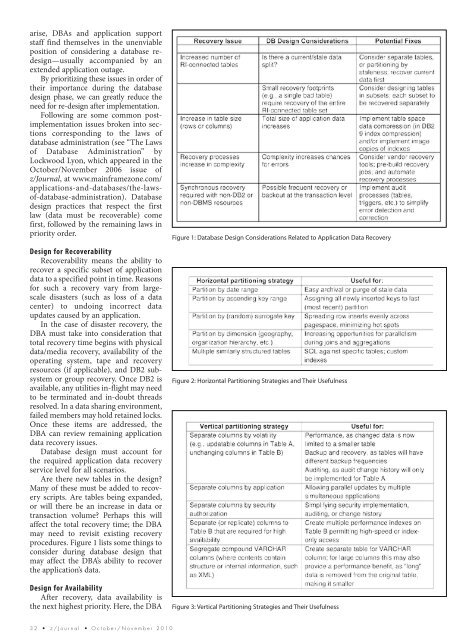z/VSE: 45 Years of Progress - z/VM - IBM
z/VSE: 45 Years of Progress - z/VM - IBM
z/VSE: 45 Years of Progress - z/VM - IBM
Create successful ePaper yourself
Turn your PDF publications into a flip-book with our unique Google optimized e-Paper software.
arise, DBAs and application support<br />
staff find themselves in the unenviable<br />
position <strong>of</strong> considering a database redesign—usually<br />
accompanied by an<br />
extended application outage.<br />
By prioritizing these issues in order <strong>of</strong><br />
their importance during the database<br />
design phase, we can greatly reduce the<br />
need for re-design after implementation.<br />
Following are some common postimplementation<br />
issues broken into sections<br />
corresponding to the laws <strong>of</strong><br />
database administration (see “The Laws<br />
<strong>of</strong> Database Administration” by<br />
Lockwood Lyon, which appeared in the<br />
October/November 2006 issue <strong>of</strong><br />
z/Journal, at www.mainframezone.com/<br />
applications-and-databases/the-laws<strong>of</strong>-database-administration).<br />
Database<br />
design practices that respect the first<br />
law (data must be recoverable) come<br />
first, followed by the remaining laws in<br />
priority order.<br />
Design for Recoverability<br />
Recoverability means the ability to<br />
recover a specific subset <strong>of</strong> application<br />
data to a specified point in time. Reasons<br />
for such a recovery vary from largescale<br />
disasters (such as loss <strong>of</strong> a data<br />
center) to undoing incorrect data<br />
updates caused by an application.<br />
In the case <strong>of</strong> disaster recovery, the<br />
DBA must take into consideration that<br />
total recovery time begins with physical<br />
data/media recovery, availability <strong>of</strong> the<br />
operating system, tape and recovery<br />
resources (if applicable), and DB2 subsystem<br />
or group recovery. Once DB2 is<br />
available, any utilities in-flight may need<br />
to be terminated and in-doubt threads<br />
resolved. In a data sharing environment,<br />
failed members may hold retained locks.<br />
Once these items are addressed, the<br />
DBA can review remaining application<br />
data recovery issues.<br />
Database design must account for<br />
the required application data recovery<br />
service level for all scenarios.<br />
Are there new tables in the design?<br />
Many <strong>of</strong> these must be added to recovery<br />
scripts. Are tables being expanded,<br />
or will there be an increase in data or<br />
transaction volume? Perhaps this will<br />
affect the total recovery time; the DBA<br />
may need to revisit existing recovery<br />
procedures. Figure 1 lists some things to<br />
consider during database design that<br />
may affect the DBA’s ability to recover<br />
the application’s data.<br />
Design for Availability<br />
After recovery, data availability is<br />
the next highest priority. Here, the DBA<br />
Figure 1: Database Design Considerations Related to Application Data Recovery<br />
Figure 2: Horizontal Partitioning Strategies and Their Usefulness<br />
Figure 3: Vertical Partitioning Strategies and Their Usefulness<br />
3 2 • z / J o u r n a l • O c t o b e r / N o v e m b e r 2 0 1 0

















